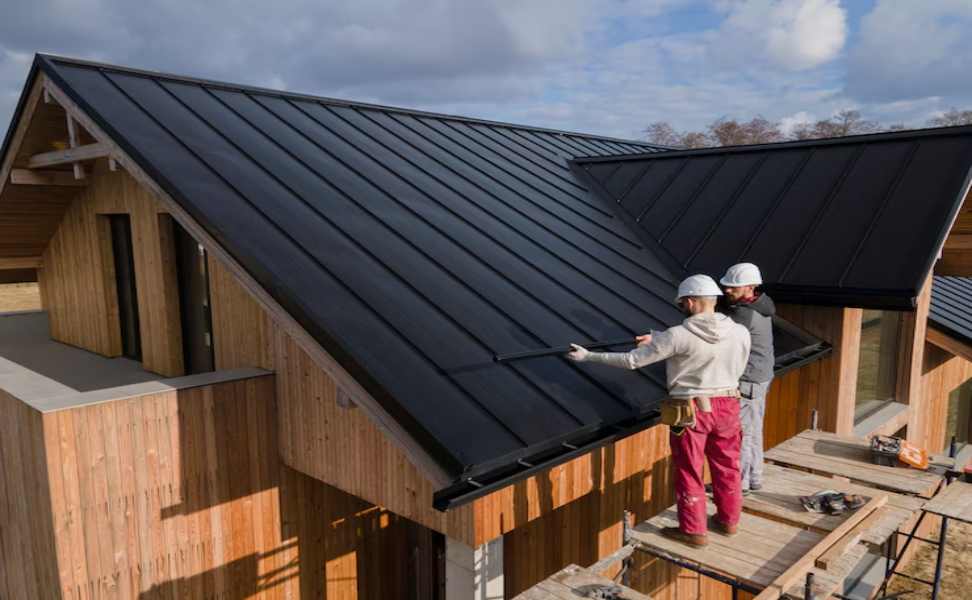While pitched roofs dominate the landscape, there’s a growing appreciation for the unique appeal and functionality of flat roofing . Flat roofs, also known as low-slope roofs, offer a distinct aesthetic and come with a surprising array of advantages. This article delves into the world of flat roofing, exploring its benefits, considerations for maintenance, and common flat roof repair challenges.
Beyond Aesthetics: The Advantages of Flat Roofs
Flat roofs offer several advantages that make them a compelling choice for modern architecture and commercial buildings:
- Usable Space: Flat roofs create a usable outdoor space that can be transformed into a rooftop patio, garden, or even a solar panel array, maximizing the functionality of your building footprint.
- Modern Aesthetic: Clean lines and a sleek profile contribute to a contemporary architectural style, making flat roofs a popular choice for commercial buildings and modern homes.
- Cost-Effectiveness: Flat roofs generally require less material compared to pitched roofs, potentially leading to lower installation costs. However, long-term maintenance costs should be factored in.
- Structural Simplicity: The simpler design of flat roofs can translate to a less complex and potentially faster construction process.
- Energy Efficiency: Flat roofs offer a platform for installing solar panels, skylights, and green roofs, promoting energy efficiency and sustainability.
Considering the Climate: Flat roofs are particularly well-suited for drier climates with minimal snowfall. In areas with heavy snowfall, the design might require additional considerations to prevent weight accumulation and drainage issues.
Maintaining the Flat Roof Advantage: Essential Upkeep Tips
While flat roofs offer advantages, they require specific maintenance considerations:
- Regular Inspections: Schedule regular inspections with qualified professionals to identify minor issues like ponding water, loose flashing, or roof membrane damage before they escalate into major repairs.
- Drainage Maintenance: Flat roofs rely on proper drainage systems to prevent water accumulation. Regularly clean gutters, downspouts, and drains to ensure proper water flow.
- Foot Traffic Management: Limit foot traffic on your flat roof as much as possible. Heavy foot traffic can damage the roof membrane and shorten its lifespan.
Flat Roof Repair Challenges: Recognizing and Addressing Potential Issues
While flat roofs offer advantages, they are also susceptible to specific challenges:
- Ponding Water: Flat roofs don’t shed water as efficiently as pitched roofs. If not properly designed or maintained, water can pool on the roof, leading to leaks and structural damage.
- Flashing Issues: Flashing, the material that seals around penetrations like chimneys and vents, is a critical component of flat roofs. Improper flashing or deterioration can lead to leaks.
Early Detection is Key: Addressing minor flat roof repair issues promptly can prevent them from escalating into major problems that require extensive repairs or even roof replacement.
Conclusion: Flat Roofing – A Considered Choice for Modern Buildings
Flat roofs offer a unique aesthetic, potential cost savings, and additional usable space. However, they require specific maintenance considerations and are susceptible to certain challenges. By understanding the advantages and potential drawbacks, and by prioritizing regular inspections and preventative maintenance, you can ensure your flat roof serves you well for years to come. So, if you’re considering a modern building design, flat roofing might be a viable option, but remember, it’s a choice that comes with its own set of considerations.
Also Read:-
- What Is A Motion Control Robot?
- What Is Hurawatch? Is It Safe To Use?
- All You Have To Know About Google In 1998


